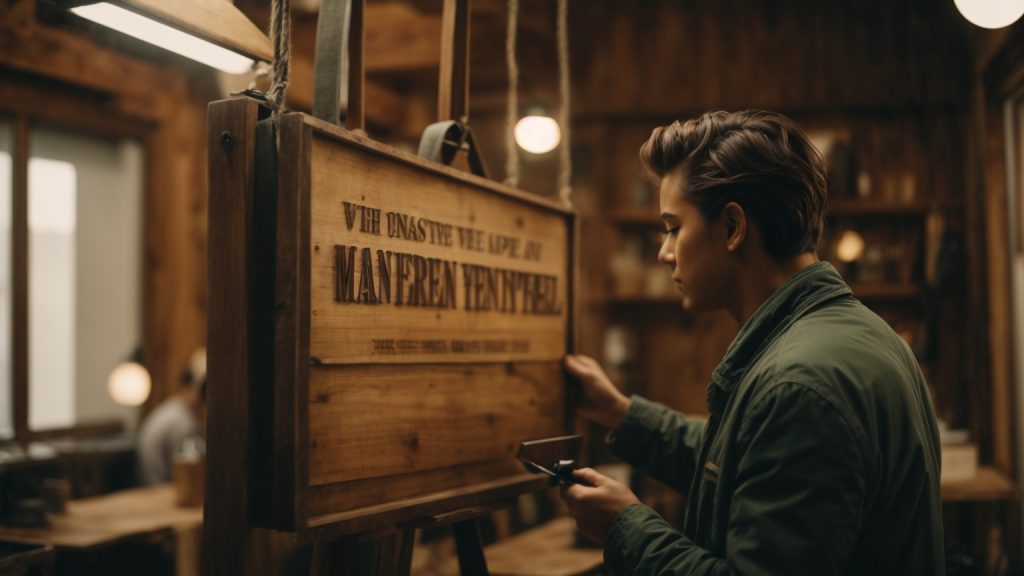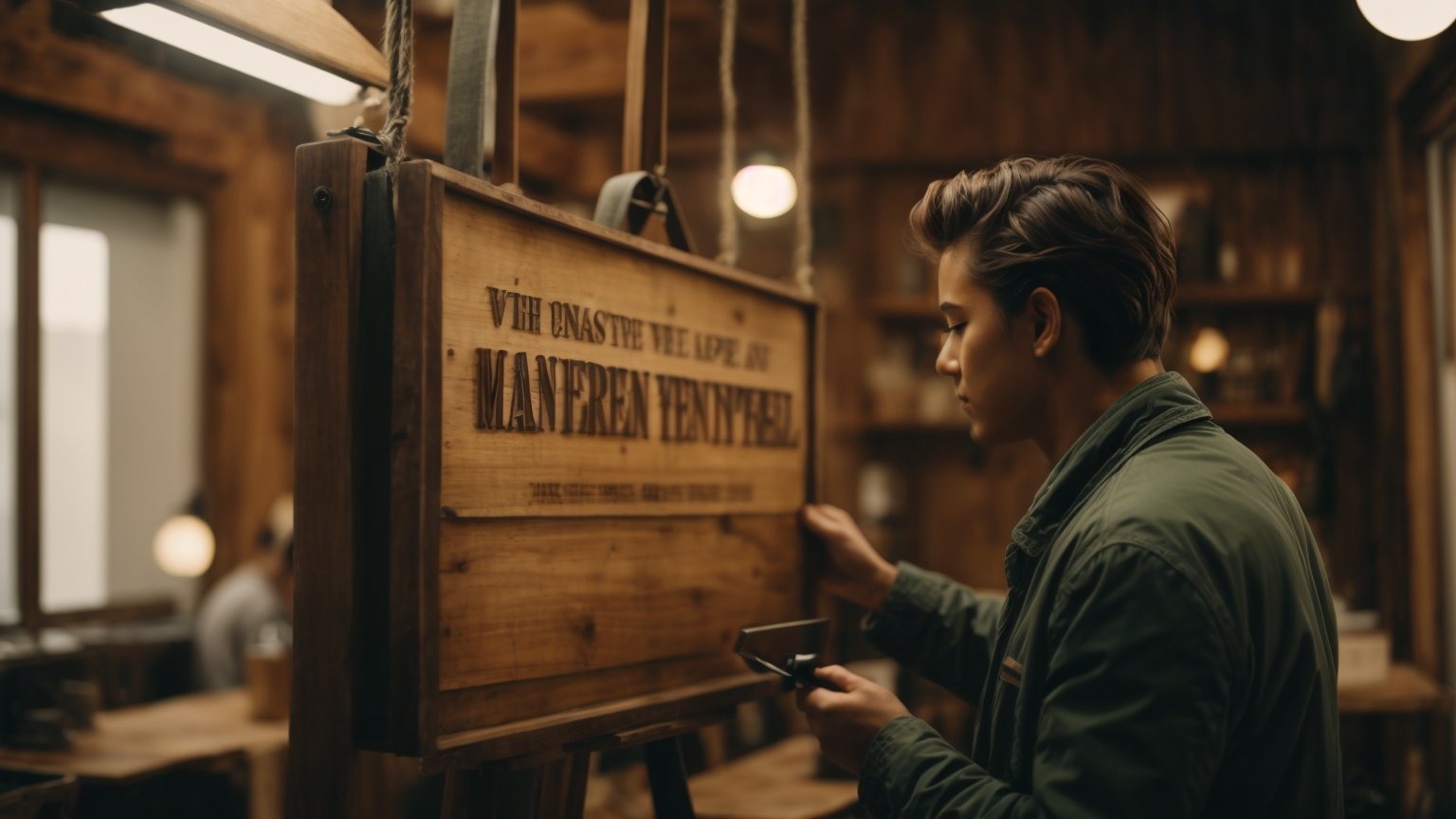Hanging a wooden sign can add a touch of rustic charm to your home or business. However, it can be tricky to know where to start. Whether you’re hanging a sign indoors or outdoors, on drywall or concrete, there are a few key things to keep in mind. In this article, we’ll guide you through the process of hanging a wooden sign, step by step.
First, you’ll need to choose the right hardware for your sign and the surface you’re hanging it on. For lightweight signs, picture-hanging hardware or a simple nail or screw may be sufficient. For heavier signs, you’ll need to use more heavy-duty hardware such as a French cleat or a Sawtooth hanger. If you’re hanging your sign on drywall, it’s important to locate a stud to ensure that it will be securely anchored. For concrete surfaces, you’ll need to use concrete screws or anchors.
Once you’ve chosen your hardware, it’s time to measure and mark the location where you want to hang your sign. Use a level to ensure that your sign will hang straight. If you’re hanging multiple signs, make sure to measure and mark the location of each one individually. With the right hardware and a little bit of careful planning, you’ll be able to hang your wooden sign in no time.
Choosing the Right Spot

When it comes to hanging a wooden sign, choosing the right spot is crucial to ensure that your sign is visible and adds to the aesthetics of the room or space. Here are some things to consider when choosing the right spot to hang your wooden sign.
Considering Wall Material
The first thing you need to consider is the material of the wall where you plan to hang your wooden sign. Some walls, such as drywall, plaster, or brick, may require specific hardware to ensure that your sign stays securely in place. Here are some things to keep in mind:
- Drywall: If you plan to hang your wooden sign on drywall, you will need to use a stud finder to locate the studs behind the drywall. Once you find the studs, you can use screws or nails to hang your sign. If you cannot find a stud, you will need to use drywall anchors to ensure that your sign stays in place.
- Plaster: Hanging a wooden sign on plaster walls can be tricky, as plaster is a brittle material that can crack easily. If you plan to hang your sign on a plaster wall, you will need to use a drill to make small holes in the wall, then use screws or nails to hang your sign. Be sure to use a drill bit that is smaller than the screw or nail to avoid damaging the plaster.
- Brick: If you plan to hang your wooden sign on a brick wall, you will need to use masonry screws or anchors to ensure that your sign stays securely in place. Be sure to use a drill with a masonry bit to make holes in the brick.
Measuring Your Space
Once you have determined the type of wall where you plan to hang your wooden sign, the next step is to measure your space. Here are some things to keep in mind:
- Height: When hanging a wooden sign, you want to make sure that it is at eye level and easy to read. The height at which you hang your sign will depend on the size of the sign and the height of the room. As a general rule, you should hang your sign so that the center of the sign is at eye level.
- Spacing: If you plan to hang multiple wooden signs, you will need to consider the spacing between the signs. You want to make sure that each sign is spaced evenly and that there is enough space between the signs to avoid overcrowding.
- Location: Finally, you will need to consider the location of your sign. If you plan to hang your sign in a high-traffic area, you will want to make sure that it is securely fastened and out of the way. If you plan to hang your sign in a more decorative area, you may want to consider using decorative hooks or hangers to add to the aesthetics of the space.
In conclusion, choosing the right spot to hang your wooden sign is crucial to ensure that it is visible and adds to the aesthetics of the room or space. Be sure to consider the type of wall where you plan to hang your sign, as well as the height, spacing, and location of the sign.
Selecting the Perfect Wooden Sign
When it comes to choosing the perfect wooden sign to hang, there are a few things you should consider. In this section, we’ll go over the different wood types you can choose from and how to select the right size for your space.
Understanding Different Wood Types
The type of wood you choose for your sign can affect its durability, appearance, and overall style. Here are some common wood types used for signs:
| Wood Type | Characteristics |
|---|---|
| Pine | Affordable, lightweight, and easy to work with. |
| Cedar | Durable, weather-resistant, and has a natural aroma. |
| Oak | Strong, heavy, and has a distinctive grain pattern. |
| Maple | Hard and dense, with a light color and uniform texture. |
Consider the style and purpose of your sign when choosing a wood type. For example, if you want a rustic or vintage look, pine or cedar may be a good choice. If you want a more polished or refined look, oak or maple may be a better option.
Choosing the Right Size
The size of your wooden sign should be proportional to the space where you plan to hang it. Here are some tips to help you choose the right size:
- Measure the space where you want to hang the sign and choose a size that fits comfortably.
- Consider the distance from which the sign will be viewed. If it will be viewed from far away, a larger size may be necessary.
- Think about the amount of text or design you want to include on the sign. If you have a lot of information to convey, a larger size may be needed to ensure legibility.
Remember, it’s always better to go slightly larger than too small when it comes to choosing the size of your wooden sign. A well-sized sign can make a big impact in your space and add a touch of personality and charm.
Gathering Necessary Tools
Before you start hanging your wooden sign, it’s important to gather all the necessary tools to ensure a smooth and safe installation process. In this section, we’ll cover the hardware essentials and safety equipment you’ll need to complete the job.
Hardware Essentials
To hang your wooden sign, you’ll need the following hardware essentials:
| Hardware | Description |
|---|---|
| Structural Screws | Sized to support the weight of your sign |
| Drill Bit | 1/16 of an inch smaller than the diameter of your structural screw |
| Stud Finder | To locate a stud behind your drywall |
| Pencil | To mark where you want to hang your sign |
| Ruler | To measure the distance between your hanger and the top of the sign |
| Level | To ensure your sign is straight |
Safety Equipment
Safety should always be a top priority when hanging a wooden sign. Here are some safety equipment you should have on hand:
- Safety Glasses: To protect your eyes from flying debris while drilling
- Work Gloves: To protect your hands from splinters and sharp edges on your wooden sign
- Ladder or Step Stool: To reach high places safely
- Power Drill: To make the installation process easier and faster
By gathering all the necessary tools and safety equipment, you’ll be able to hang your wooden sign with ease and confidence.
Preparation Steps
Before hanging your wooden sign, you need to make sure you have all the necessary tools and materials. Here are the preparation steps to follow:
Marking the Wall
The first step is to determine where you want to hang your wooden sign. Use a stud finder to locate the studs behind the drywall. Once you locate the studs, mark their location on the wall using a pencil. This will ensure that your sign is securely anchored to the wall.
Preparing the Sign
Before hanging your wooden sign, you need to prepare it. Here are the steps to follow:
- Determine the weight of your sign: The weight of your sign will determine the type of hardware you need to use to hang it. Use a scale to weigh your sign.
- Choose the right hardware: There are different types of hardware you can use to hang your wooden sign, including sawtooth hangers, keyhole hangers, and D-ring hangers. Choose the hardware that is appropriate for the weight of your sign.
- Attach the hardware to the sign: Once you have chosen the hardware, attach it to the back of your sign using screws or nails. Make sure the hardware is securely attached to the sign.
By following these preparation steps, you will ensure that your wooden sign is securely anchored to the wall and will not fall down.
Hanging the Wooden Sign

When it comes to hanging a wooden sign, there are a few things to keep in mind to ensure it is secure and stable. In this section, we will go over how to secure the sign and how to check for stability.
Securing the Sign
Before you begin hanging the sign, make sure you have the necessary tools and hardware. You will need a stud finder, a pencil, a ruler, a power drill, a 3 1/2 inch structural screw, and a drill bit that is 1/16 of an inch smaller than the diameter of your structural screw. You may also need a spirit or digital level to ensure the sign is straight.
To secure the sign, follow these steps:
- Use the stud finder to locate a stud behind your drywall where you want to hang the sign.
- Mark the location of the stud with a pencil.
- Measure and mark the placement of the sign on the wall.
- Use the power drill to drill a hole into the stud at the marked location.
- Insert the structural screw into the hole and tighten it with a screwdriver.
- Hang the sign on the screw.
Checking for Stability
After hanging the sign, it is important to check for stability to ensure it will not fall or become loose over time. Here are some tips for checking the stability of your wooden sign:
- Use a level to check that the sign is straight.
- Gently shake the sign to see if it feels loose or wobbly.
- Check the screw and hardware to make sure they are tight and secure.
- If the sign feels unstable, remove it and repeat the process, making sure to secure it into a stud.
By following these steps, you can ensure that your wooden sign is securely and stably hung on your wall.
Maintaining Your Wooden Sign
Cleaning Tips
To keep your wooden sign looking great, it’s important to clean it regularly. Here are some tips to help you keep your sign clean:
- Use a soft-bristled brush to remove any loose dirt or debris from the surface of the sign.
- Mix a solution of warm water and mild detergent, such as dish soap or laundry detergent.
- Dip a clean cloth or sponge into the solution and wring out any excess water.
- Gently scrub the surface of the sign with the cloth or sponge, being careful not to apply too much pressure.
- Rinse the sign with clean water and dry it thoroughly with a clean towel or cloth.
Periodic Checks
In addition to regular cleaning, it’s also important to periodically check your wooden sign for any signs of damage or wear. Here are some things to look for:
- Check the mounting hardware to make sure it’s still secure and in good condition.
- Look for any cracks or splits in the wood, which could indicate that the sign is starting to deteriorate.
- Check for any signs of discoloration or fading, which could indicate that the sign is being exposed to too much sunlight or moisture.
By following these simple tips, you can help ensure that your wooden sign stays in great condition for years to come.
